
The Changing Racial and Ethnic Composition of the U.S. Electorate
In battleground states, Hispanics grew more than other racial or ethnic groups as a share of eligible voters
The upcoming 2020 presidential election has drawn renewed attention to how demographic shifts across the United States have changed the composition of the electorate.
For this data essay, we analyzed national and state-level shifts in the racial and ethnic makeup of the United States electorate between 2000 and 2018, with a focus on key battleground states in the upcoming 2020 election. The analysis is primarily based on data from the U.S. Census Bureau’s American Community Survey and the 2000 U.S. decennial census provided through Integrated Public Use Microdata Series (IPUMS) from the University of Minnesota.
See here to read the data essay’s methodology for further details on our data sources.
Eligible voters refer to persons ages 18 and older who are U.S. citizens. They make up the voting-eligible population or electorate. The terms eligible voters, voting eligible, the electorate and voters are used interchangeably in this report.
Registered voters are eligible voters who have completed all the documentations necessary to vote in an upcoming election.
Voter turnout refers to the number of people who say they voted in a given election.
Voter turnout rate refers to the share of eligible voters who say they voted in a given election.
Naturalized citizens are lawful permanent residents who have fulfilled the length of stay and other requirements to become U.S. citizens and who have taken the oath of citizenship.
The terms Latino and Hispanic are used interchangeably in this report. Hispanics are of any race.
References to Asians, Blacks and Whites are single-race and refer to the non-Hispanic components of those populations.
Battleground states include Arizona, Florida, Michigan, North Carolina, Pennsylvania and Wisconsin. These states were identified by Pew Research Center using ratings from a variety of sources, see the methodology for more details.
In all 50 states, the share of non-Hispanic White eligible voters declined between 2000 and 2018, with 10 states experiencing double-digit drops in the share of White eligible voters. During that same period, Hispanic voters have come to make up increasingly larger shares of the electorate in every state. These gains are particularly large in the Southwestern U.S., where states like Nevada, California and Texas have seen rapid growth in the Hispanic share of the electorate over an 18-year period.1
These trends are also particularly notable in battleground states – such as Florida and Arizona – that are likely to be crucial in deciding the 2020 election.2 In Florida, two-in-ten eligible voters in 2018 were Hispanic, nearly double the share in 2000. And in the emerging battleground state of Arizona, Hispanic adults made up about one-quarter (24%) of all eligible voters in 2018, up 8 percentage points since 2000.
To be sure, the demographic composition of an area does not tell the whole story. Patterns in voter registration and voter turnout vary widely by race and ethnicity, with White adults historically more likely to be registered to vote and to turn out to vote than other racial and ethnic groups. Additionally, every presidential election brings its own unique set of circumstances, from the personal characteristics of the candidates, to the economy, to historic events such as a global pandemic. Still, understanding the changing racial and ethnic composition in key states helps to provide clues for how political winds may shift over time.
Black, Hispanic and Asian registered voters historically lean Democratic
The ways in which these demographic shifts might shape electoral outcomes are closely linked to the distinct partisan preferences of different racial and ethnic groups. Pew Research Center survey data spanning more than two decades shows that the Democratic Party maintains a wide and long-standing advantage among Black, Hispanic and Asian American registered voters.3 Among White voters, the partisan balance has been generally stable over the past decade, with the Republican Party holding a slight advantage.
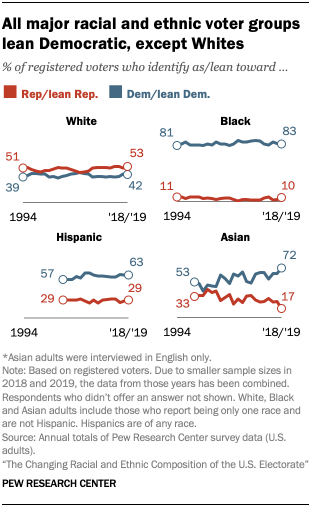
National exit polling data tells a similar story to partisan identification, with White voters showing a slight and fairly consistent preference toward Republican candidates in presidential elections over the last 40 years, while Black voters have solidly supported the Democratic contenders. Hispanic voters have also historically been more likely to support Democrats than Republican candidates, though their support has not been as consistent as that of Black voters.4
These racial and ethnic groups are by no means monolithic. There is a rich diversity of views and experiences within these groups, sometimes varying based on country of origin. For example, Pew Research Center’s 2018 National Survey of Latinos found that Hispanic eligible voters of Puerto Rican and/or Mexican descent – regardless of voter registration status – were more likely than those of Cuban descent to identify as Democrats or lean toward the Democratic Party (65% of Puerto Rican Americans and 59% of Mexican Americans vs. 37% of Cuban Americans identified as Democrats). A majority of Cuban eligible voters identified as or leaned toward the Republican Party (57%).
Among Asian American registered voters, there are also some differences in party identification by origin group. For instance, Vietnamese Americans are more likely than Asians overall to identify as Republican, while the opposite is true among Indian Americans, who tend to lean more Democratic.
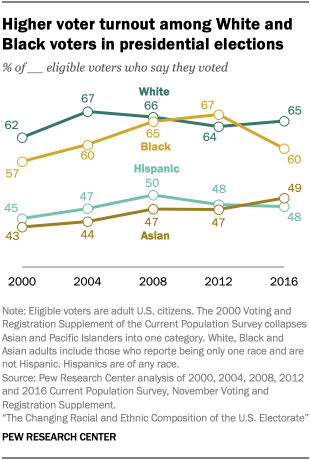
Given these differences within racial and ethnic groups, the relative share of different origin groups within a specific state can impact the partisan leanings of that state’s electorate. For example, in Florida, Republican-leaning Cubans had historically been the largest Hispanic origin group. However, over the past decade, the more Democratic-leaning Puerto Ricans have been the state’s fastest-growing Hispanic-origin group, and they now rival Cubans in size. At the same time, in states like California and Nevada, Mexican Americans, who tend to lean Democratic, are the dominant Hispanic origin group.
Partisan alignment does not tell the whole story when it comes to voting patterns. Voter turnout rates – or the share of U.S. citizens ages 18 and older who cast a ballot – also vary widely across racial and ethnic groups. White adults historically have had the highest rate of voter turnout: About two-thirds of eligible White adults (65%) voted in the 2016 election. Black adults have also historically had relatively high rates of voter turnout, though typically slightly lower than White adults. There was an exception to this pattern in 2008 and 2012, when Black voter turnout matched or exceeded that of Whites. By contrast, Asian and Hispanic adults have had historically lower voter turnout rates, with about half reporting that they voted in 2016.
White and Black adults are also more likely than Hispanic and Asian adults to say that they are registered to vote.
Non-White eligible voters accounted for more than three-quarters of total U.S. electorate growth since 2000
The non-White voting population has played a large role in driving growth in the nation’s electorate. From 2000 to 2018, the nation’s eligible voter population grew from 193.4 million to 233.7 million – an increase of 40.3 million. Voters who are Hispanic, Black, Asian or another race or ethnicity accounted for more than three-quarters (76%) of this growth.
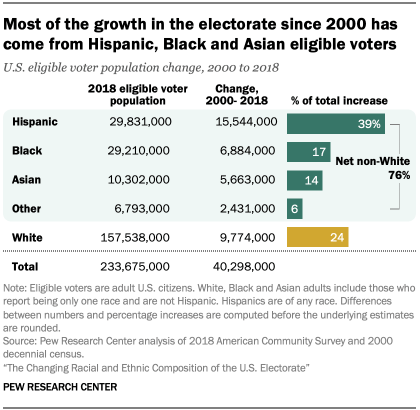
The substantial percentage point increase of voters who are not White as a share of the country’s overall electorate was largely driven by second-generation Americans – the U.S.-born children of immigrants – coming of age, as well as immigrants naturalizing and becoming eligible to vote. The increase has been steady over the past 18 years – from 2000 to 2010, their share rose by 4 percentage points (from 24% to 28%), while from 2010 to 2018, their share further grew by 5 points (up from 28% to 33%).
Hispanic eligible voters were notably the largest contributors to the electorate’s rise. They alone accounted for 39% of the overall increase of the nation’s eligible voting population. Hispanic voters made up 13% of the country’s overall electorate in 2018 – nearly doubling from 7% in 2000. The population’s share grew steadily since 2000, with similar percentage point growth observed between 2000 and 2010 (3 points) and 2010 and 2018 (3 points).
The Hispanic electorate’s growth primarily stemmed from their U.S.-born population coming of age. The 12.4 million Hispanics who turned 18 between 2000 and 2018 accounted for 80% of the growth among the population’s eligible voters during those years. The group’s sustained growth over the past two decades will make Hispanics the projected largest minority group among U.S. eligible voters in 2020 for the first time in a presidential election.
Asian eligible voters also saw a significant rise in their numbers, increasing from 4.6 million in 2000 to 10.3 million in 2018. And similar to Hispanics, their nearly two-decade growth has been relatively consistent. The population’s share in the electorate grew at similar rates from 2000 to 2010 and from 2010 to 2018 (1 point each). In 2018, Asian eligible voters made up 4% of the nation’s electorate (up from 2% in 2000), the smallest share out of all major racial and ethnic groups. Naturalized immigrants – a group that makes up two-thirds of the Asian American electorate – are the main driver of the Asian electorate’s growth. From 2000 to 2018, the number of naturalized Asian immigrant voters more than doubled – from 3.3 million to 6.9 million – and their growth alone accounted for 64% of the overall growth in the Asian electorate.
Despite notable growth in the non-White eligible voter population, non-Hispanic White voters still made up the large majority (67%) of the U.S. electorate in 2018. However, they saw the smallest growth rate out of all racial ethnic groups from 2000 to 2018, causing their share to shrink by nearly 10 percentage points.
Shares of non-Hispanic White eligible voters have declined in all 50 states
The overall decline in the shares of the non-Hispanic White eligible voter population can be observed across all states. (There hasn’t been a decline in the District of Columbia.) While this trend is not new, it is playing out to varying degrees across the country, with some states experiencing particularly significant shifts in the racial and ethnic composition of their electorate.
In total between 2000 and 2018, 10 states saw a 10 percentage point or greater decline in the share of White eligible voters. In Nevada, the White share of the electorate fell 18 percentage points over almost two decades, the largest drop among all 50 states. The decline in the White share of the electorate in Nevada has been fairly steady, with a comparable percentage point decline observed between 2000 and 2010 (10 points) and 2010 and 2018 (8 points). California has experienced a similarly sharp decline in the White share of the electorate, dropping 15 percentage points since 2000. This has resulted in California changing from a majority White electorate in 2000 to a state where White voters were a minority share of the electorate in 2018 (60% in 2000 to 45% in 2018), though they still are the largest racial or ethnic group in the electorate.
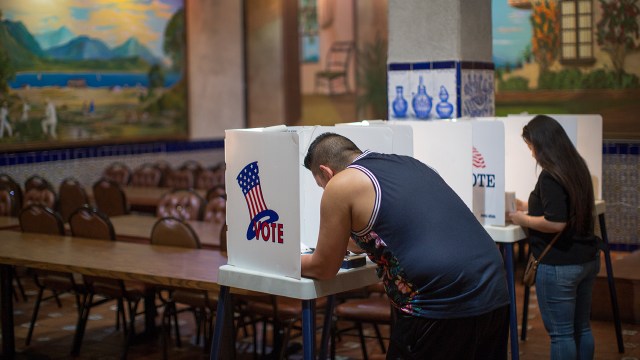
Even with declines in all 50 states, White eligible voters still make up the majority of most states’ electorates. In 47 states, over half of eligible voters are White. The only exceptions are California, New Mexico and Hawaii, where White voters account for 45%, 43% and 25% of each respective state’s electorate.
As reflected on the national level, Hispanic eligible voters have been the primary drivers of the racial and ethnic diversification of most states’ electorates. In 39 states between 2000 and 2018, Hispanic eligible voters saw the largest percentage point increase compared with any other racial or ethnic group. In three additional states – Alaska, Kentucky and Ohio – Hispanic voters were tied with another racial group for the highest increase. Five states that observed the largest growth in Hispanic shares in their electorates were California (11 percentage points), Nevada (10 points), Florida (9 points), Arizona (8 points) and Texas (8 points).
The number of Black eligible voters nationwide grew only slightly in the past 18 years. Even so, Black voters saw the largest percentage point increase out of any other racial and ethnic group in three states in the Southeast: Georgia (5 points), Delaware (4 points) and Mississippi (4 points).
As for Asian eligible voters, they saw robust growth in California (5 percentage points), Nevada and New Jersey (4 points each) between 2000 and 2018. However, their share increases paled in comparison to the Hispanic electorate’s growth in those states. Overall, Asians saw their shares increase in the electorates of every state except Hawaii, where their share dropped by 4 percentage points. Still, Hawaii has the highest percentage of Asians in its electorate – 38% of all eligible voters in the state are Asian.
Racial and ethnic change among eligible voters in battleground states
As the 2020 presidential election draws near, these demographic shifts are particularly notable in some key battleground states, where changes in the composition of the electorate could have an impact on electoral outcomes.5
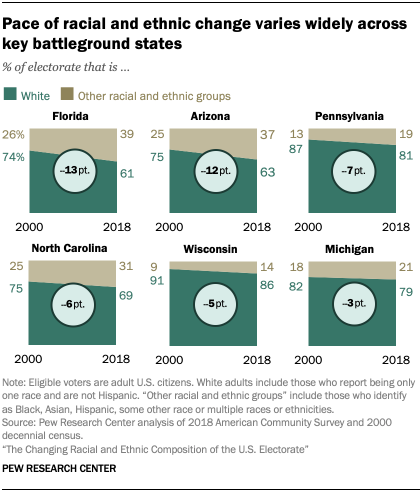
Nationally, Florida and Arizona saw the third- and fourth-largest declines in the shares of non-Hispanic White eligible voters. The White shares of the electorate in those states each stood at about six-in-ten in 2018, down from about three-quarters at the start of the century. Four other battleground states – Pennsylvania, North Carolina, Wisconsin and Michigan – also saw declines in the share of White eligible voters between 2000 and 2018, though to a lesser extent.
In Florida, a state that has been pivotal to every U.S. presidential victory in the last 20 years, the White share of the electorate has fallen 13 percentage points since 2000. At the same time, the Hispanic share of the electorate has gone up 9 points, rising from 11% of eligible Florida voters in 2000 to 20% in 2018. During this same period, the Black share of the electorate in Florida has increased 2 percentage points and the Asian share has increased by 1 point.
Arizona, largely seen as an emerging battleground state, has seen substantial change to the racial and ethnic composition of its electorate. Hispanic adults now make up about one-quarter of all eligible voters (24%), an 8-point increase since 2000.
Several battleground states have seen smaller – though still potentially meaningful – changes to the demographic composition of the electorate. In Pennsylvania, the White share of the electorate fell 7 percentage points while the Hispanic share of the electorate rose 3 points from 2000 to 2018. And in North Carolina, a state that voted for Donald Trump in 2016 and previously went for Barack Obama, George W. Bush and Bill Clinton, the White share of the electorate fell from 75% in 2000 to 69% in 2018. During the same time period, the Hispanic share of the electorate rose to 4% (up 3 points since 2000) and the Black share of the electorate rose to 22% (up 1 point since 2000).
Demographic changes could continue to reshape the electoral landscape in future elections. While Texas is not currently considered a battleground state, demographic shifts have led some to wonder if the state could become more competitive politically down the road. In 2018, three-in-ten eligible voters in Texas were Hispanic – that’s up 8 percentage points since 2000. During that same time, the share of White eligible voters in Texas fell 12 points, from 62% in 2000 to a bare majority (51%) in 2018.


